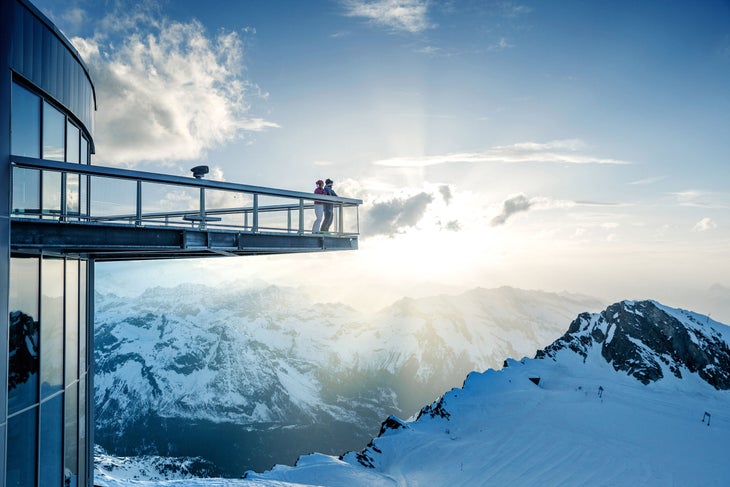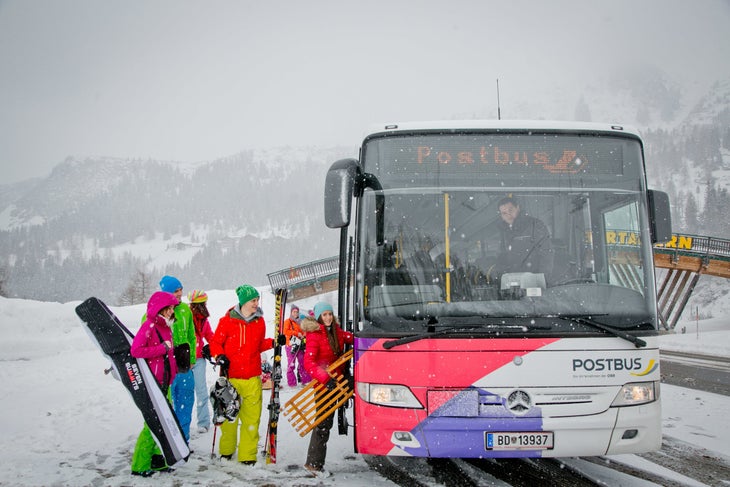At the ski resorts of the future, skiers will arrive by free trains and buses, no cars necessary. They’ll ride lifts powered by 100 percent renewable energy and carve down runs groomed with machines that run on cutting-edge clean fuel. Ultraefficient snowmaking that saves power and water will supplement winter’s bounty. When skiers finally unbuckle their boots, they’ll browse regional crafts and savor après food and drink sourced from local producers. It’s both inspiring and just plain fun—a better way to ski—and you don’t have to wait for the future. It’s already possible in Austria.��
Long known for breathtaking alpine scenery, excellent snow, and a special kind of hospitality, Austria’s ski resorts are making a new name for themselves in groundbreaking sustainability. As concern over the climate crisis deepens and organizations strive to slash their carbon footprints, Austrian resorts are taking the lead in eco-friendly practices. Not only because their existence depends on reliable snow, but also because they share a deep commitment to their communities, the conservation of their stunning alpine ecosystems, and a healthier planet for all.

Austria’s ski resorts are making a new name for themselves in groundbreaking sustainability. (Photo: Zell am See-Kaprun / Kitzsteinhorn)
Austria’s top resorts are approaching sustainability measures from all angles. Many run their buildings and lifts on renewable energy. They encourage guests to take car-free vacations with accessible and widespread public transportation options. Their snowmaking machines use new technology and data analysis to save energy and water. And resorts prioritize a sense of place, whether that’s through protecting habitat for local flora and fauna or featuring regional specialties in their restaurants and shops.��
Even better? From hassle-free travel to local delicacies, a sustainable ski experience is also a more enjoyable one. Here’s how several pioneering ski mountains are integrating sustainability into everyday operations.
Renewable Energy
Some top Austrian resorts have already moved from powering their infrastructure with fossil fuels to 100 percent renewable energy. Ski Arlberg for example is one of the largest ski resorts in the world and their ski powerhouses St. Anton and Lech Zürs are run on its own independent hydroelectric plant. St. Anton also has its own biomass heating plant. Lech Zürs heats its cable cars, ski lifts, and almost all the surrounding homes and businesses with four biomass heating plants that use regionally sourced wood chips. And all its operations, from cable cars to lifts to restaurants, run on 100 percent pumped-storage hydropower.

�����ٳ���ü������also taps green energy for its cable cars and lifts, using a mix of hydropower and solar power.��Snow Space Salzburg—a collection of the adjoining ski resorts of��Flachau,��Wagrain, and��St. Johann-Alpendorf—has also moved to 100 percent renewable energy for its cable cars and snowmaking machines, part of its ambitious plan to reach carbon neutrality by the 2025–2026 season. At��Zell am See-Kaprun, lifts run on green energy, and the resort captures excess heat generated by several cable car motors and uses it to heat buildings. Clean energy also powers the Nordic playground of��Region��Seefeld, a frequent host of Olympic and World Cup skiing events. Solar panels and a biomass heating system supply many of its businesses and homes. Plus, street and building lighting systems often use automatically adapting LED bulbs to boost efficiency.
Greener Transportation
Much of a ski resort’s carbon footprint comes from the transportation its guests use to travel to and from the slopes. By making it easy for people to leave their cars at home and use cleaner public transit instead, Austria’s resorts are slashing emissions.�������ٳ���ü������boasts the largest free ski transit network in the Alps, with buses (many of them electric) connecting all the valley stations in the area. (There are also electric-vehicle charging stations in its parking lots.) Similarly,��Zell am See-Kaprun��promotes car-free vacations—and from spring through fall even offers free train and bus travel throughout the region via its Mobility Card program. Travelers can also use a single guest card to take advantage of��Region Seefeld’s buses and trains. The Blue Fleet at��Lech Zürs��includes free ski buses, and additionally they offer e-bikes for rent, and an e-garage for guests to charge EVs.��St. Anton��is another easy car-free destination, thanks to its connection to the international rail system and regular buses.

Better Snowmaking and Grooming
Many resorts must augment natural snowfall with manmade flakes—historically an energy- and water-intensive operation—but�������ٳ���ü������employs innovative technology to maximize snowmaking efficiency. The resort has analyzed its runs, considering factors like elevation and slope exposure, to determine exactly how much snow each area needs. Then, it measures snow depth using GPS data to make sure its snowmaking machines produce only as much snow as necessary, saving energy and water. And at Kitzsteinhorn at��Zell am See-Kaprun, a small pumped hydroelectric plant can make snow in winter; when the weather warms up, that snow’s meltwater is transformed into hydropower for the area. Snow grooming also requires significant energy, so clean tech makes a big impact. Starting this season, the glacier lifts in Zell am See-Kaprun will operate its snow groomers entirely with a renewable HVO100 fuel, a fossil-free diesel substitute made from natural waste products such as used cooking oils and, according to the manufacturer, releases 90 per cent less carbon dioxide. And Snow Space Salzburg��debuted a one-of-a-kind hydrogen-powered groomer in January 2023, paving the way for mass production by 2025.
Regional Focus
Across Austria, restaurants and hotels are becoming increasingly focused on offering regional cuisine and locally sourced ingredients. A global leader in organic farming, Austria is home to more than 24,000 certified organic farms—which make up 22 percent of the total farms in the country.
You’ll also find plenty of outstanding local ski, equipment, and fashion brands while browsing stores in the the pedestrian-friendly ski towns. Some of the most iconic brands—like Hannes Strolz ski boots in Lech, or Frauenschuh fashion in Kitzbühel—come with a multi-generational legacy and history. There are also several noteworthy start-ups, such as Innsbruck-based SPURart, which makes completely customized, handmade skis and snowboards. SPUart even offers visitors the opportunity to design and create their own gear during weekend-long workshops. Overall, this regional focus on production and supply chain reduces the carbon impact of shipping goods across long distances while also protecting Austria’s cultural heritage and creating a strong sense of place for travelers and locals alike.

Resort restaurants in Austria source fresh, local ingredients for dishes. (Photo: Lech Zürs / Daniel Zangerl)
Community Legacy
The origin and evolution of Austria’s ski industry makes it special. Over the last century, its resorts have grown organically out of small communities centered around farming, trade, and mining. Today, many of the resorts’ ��top hotels, restaurants, shops, and businesses remain under the loving care of the families that established them. This legacy stands in contrast to the trend in the United States and elsewhere, where corporate giants manage resorts. Instead, Austria’s ski destinations are intertwined with the community’s lifeblood, and this deeply rooted connection has spurred a commitment to tackling today’s challenges head-on.
Greener, great food and culture, and easy travel: Austria is showing the way to a better future for all skiers. your Austrian ski adventure.
The (ANTO) is Austria’s national tourism organization. Since 1955, the main objective has been the promotion of Austria as a vacation destination. To learn more about ANTO or what to explore in Austria, visit .

